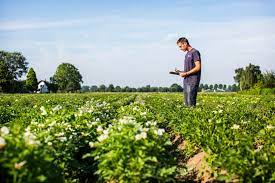A Tiny country feeds the world !
It is time we in India, more so from Indian agriculture universities and other agri teaching institutes, should become updated with what is happening in other parts of the world. New agriculture research and new agri innovations. We started from here and next few months we read more about other new discoveries and new developments in other parts of the world— Editor
The world agriculture is changing. And how it is changed in the tiny European country The Netherlands! Here are some brief notes from National Geographic magazine.
Almost two decades ago the Dutch made a national commitment to sustainable agriculture under a rallying cry, “Twice as much food using half as much resources”. Since 2000 the farmers have reduced water for key crops more than 90 percent. They have also completely eliminated the use of chemical pesticides on plants in greenhouses.

The Netherlands is a small, densely populated country, with more than 1,300 inhabitants per square mile. It’s bereft of almost every resource long thought to be necessary for large-scale agriculture. Yet it’s the globe’s number two exporter of food as measured by value, second only to the United States, which has 270 times its landmass. How on Earth have the Dutch done it?
Seen from the air, the Netherlands resembles no other major food producer—a fragmented patchwork of intensely cultivated fields, most of them tiny by agribusiness standards, punctuated by bustling cities and suburbs. In the country’s principal farming regions, there’s almost no potato patch, no greenhouse, no hog barn that’s out of sight of skyscrapers, manufacturing plants, or urban sprawl. More than half the nation’s land area is used for agriculture and horticulture.
Banks of what appear to be gargantuan mirrors stretch across the countryside, glinting when the sun shines and glowing with eerie interior light when night falls. They are Holland’s extraordinary greenhouse complexes, some of them covering 175 acres.
These climate-controlled farms enable a country located a scant thousand miles from the Arctic Circle to be a global leader in exports of a fair-weather fruit: the tomato. The Dutch are also the world’s top exporter of potatoes and onions and the second largest exporter of vegetables overall in terms of value. More than a third of all global trade in vegetable seeds originates in the Netherlands.
The brain trust behind these astounding numbers is centred at Wageningen University & Research (WUR), located 50 miles southeast of Amsterdam. Widely regarded as the world’s top agricultural research institution, WUR is the nodal point of Food Valley, an expansive cluster of agricultural technology start-ups and experimental farms. The name is a deliberate allusion to California’s Silicon Valley, with Wageningen emulating the role of Stanford University in its celebrated merger of academia and entrepreneurship.
Ernst van den Ende, managing director of WUR’s Plant Sciences Group, embodies Food Valley’s blended approach. A renowned scholar with the casual manner of a barista at a hip café, van den Ende is a world authority on plant pathology. But, he says, “I’m not simply a college dean. Half of me runs Plant Sciences, but the other half oversees nine separate business units involved in commercial contract research.” Only that mix, “the science-driven in tandem with the market-driven,” he maintains, “can meet the challenge that lies ahead.”
The challenge? Put in bluntly apocalyptic terms, he says, the planet must produce “more food in the next four decades than all farmers in history have harvested over the past 8,000 years.”
That’s because by 2050, the Earth will be home to as many as 10 billion people, up from today’s 7.5 billion. If massive increases in agricultural yield are not achieved, matched by massive decreases in the use of water and fossil fuels, a billion or more people may face starvation. Hunger could be the 21st century’s most urgent problem, and the visionaries working in Food Valley believe they have found innovative solutions.
The wherewithal to stave off catastrophic famine is within reach, van den Ende insists. His optimism rests on feedback from more than a thousand WUR projects in more than 140 countries and on its formal pacts with governments and universities on six continents to share advances and implement them.